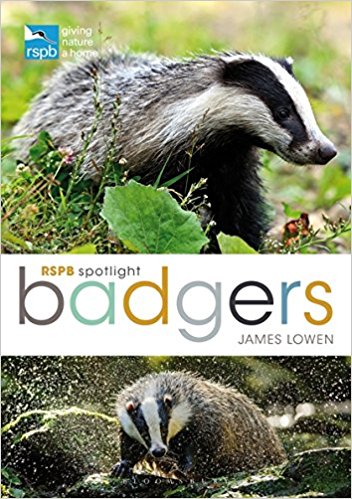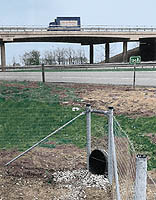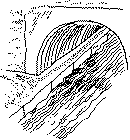Badger Tunnels
| RSPB Spotlight on Badgers book |
 |
James
Lowen explores the lives of badgers and their communal
living, feeding habits and threats to their conservation. Click
here to buy:
Paperback edition
Kindle edition
|
Dutch Badger Tunnels
Until the 1990s, 20 percent of the badger population in the
Netherlands were killed every year on the country's highways.
As their habitats were destroyed - for example, by intensive
farming - the animals had fewer places to live and no
easily-available food. When they ventured away from their setts to
hunt for food, they often had to cross roads, where they were
usually killed.
Early fences and tunnels to prevent road kill and allow movement
were not highly successful. The fences were too low and were not
anchored in the ground, allowing the badgers to climb over or
crawl under them and onto the road. The fences also frequently
developed large holes, so they offered little protection. These
deficiencies were corrected in later projects. Near the town of
Heumen, for example, the national Ministry of Transport
constructed five tunnels under the highway and built higher,
stronger fences. Escape gates were put in the fences at
one-kilometer-intervals to protect any badgers that ended up on
the road. These meant the badgers could get off the roads, but
couldn't get back on again.
That's not all. Workers created a "green network"
between the badger sets, and Heumen Municipality incorporated
rules for protecting the setts into its by-laws. Together, the
fences, tunnels, green space, and habitat protection have resulted
in nearly doubling the local badger population.
As for the badgers safely crossing the road...Infrared cameras
and tracks in sand and ink beds demonstrate the animals are using
the Heumen tunnels almost every night. Foxes, rabbits, and
hedgehogs also travel through them.
 This
badger tunnel under A73 near the town of Heumen was the first to
be built in the Netherlands. As well as the vitally-important
result that it has reduced the number of road traffic accidents;
it has also meant that habitats and territories can be linked
across both sides of the motorway. This
badger tunnel under A73 near the town of Heumen was the first to
be built in the Netherlands. As well as the vitally-important
result that it has reduced the number of road traffic accidents;
it has also meant that habitats and territories can be linked
across both sides of the motorway.
Similar successes have been reported on badger-tunnel projects
in other parts of the country. In fact, badger tunnels in the
Netherlands have been so effective it is now standard procedure to
consider them for every new highway project.
For more information, please select the following link:
British Badger Tunnels
Because so many badgers are killed on the roads here in the UK
too,
the British highways people are increasingly providing tunnels under roads
to provide safe passages for wildlife. As well as helping the
local wildlife, this can also cut down the number of road
accidents too.
In fact, one of the first British purpose-built tunnels
was built for badgers as long ago as 1976. Under the M5 motorway
(near Wellington in Somerset, England), the idea of the tunnel was
that it should prevent them from being run over by traffic. The
tunnel was specially located to intersect a badger path leading
from the main sett to badgers feeding grounds.
At first this safe, underground route did not
really seem to be working, as the badgers studiously avoided using
it. Despite the fact that the tunnel was specially designed to
save badgers' lives and to prevent accidents, and that it was
filled with suitable bait, and badger smells (called musk), they still didn't
use it.
It was only when the badger family had several
cubs to rear (and needed better food supplies) that they
officially opened the site. All in all, it took the badgers nearly
three years to open their tunnel, although they quickly claimed
the territory as their own, by placing latrines at either end.
That said, the tunnel has certainly saved the
lives of badgers and prevented many potential accidents on a busy
section of motorway - money very well spent.
Culverts
Of course, with the construction of any new (or
widening an existing road), culverts will normally be constructed
to allow for surface water to be drained away - either as new
small soakaways, or to accommodate existing water courses, like
streams, river and drains.
|
Given that these will be constructed anyway, it
is a relatively easy task to construct them to allow the safe
passage of wildlife species as well as water. If a semi-circular galvanized corrugated steel culvert is being built to take a
stream under an embankment, then the culvert should be widened to
allow the maximum expected flow of water. Along one or both sides
of the culvert should be a raised platform which will allow the
badger to use the culvert without entering the stream or river.
The platform needs to be higher than the maximum expected water
level and roughly 60cm wide. As well as being
"badger-friendly", such a platform can also prove useful
during the tunnel construction process, and for later maintenance
tasks. It can also be useful to maintain the structural strength
of the culvert in the event of major flooding; and provide a
chance of an escape route in the event of children being too
inquisitive for their own good. |

Click
image to see a larger picture
|
If a tunnel is needed through en embankment,
the tunnel needs to be at least 60cm in diameter, and preferably
use concrete drainage pipes. These should be laid on a gentle
slope to allow water to to run off or through, so the tunnel is
not waterlogged. If the tunnel has too steep a slope, wildlife
will tent to slip on the smooth concrete floor. If the tunnel will
have any tendency to collect water (for example due to ground
conditions or because its lowest point is underground), it should
have a substantial soakaway.
Drainage ditches will also pose a potential
obstacle for wildlife species; and these may need to be fenced off
accordingly; and small wildlife installed to cross the ditches in
safety.
As in the case of tunnels, badger-proof fencing
should direct badgers towards the culverts. Suitable planting
schemes may be used around the tunnels or culverts entrances or
exits, if the badgers are felt to be vulnerable to being spotted
at that point (for example, in residential areas). Ideally, the
siting of these over or underpasses should relate to the position
of the local setts and badger paths, and particularly where a
hedgeline or some other linear feature would lead the badgers to
the tunnel entrance.
Badgers usually take some time to start using
tunnels (sometimes measured in years!). To help them start, some
people have laid a scent trail of anethol to the tunnel entrance
or have pulled the bodies of accidentally killed badgers through
tunnels to lay badger scent in the pipe. If you are absolutely
certain of the group's territorial boundary, scent trails of
bedding and dung from that particular group of badgers may help
lead the badgers through the tunnel, as will sugar-coated peanuts
and other badger treats.
The earlier the authorities are told of the
need for badger tunnels, the more likely it is that they are to be
included in the plan. This is a key area for local experts, like
the local Badger Groups.
Badgers will be tempted to use the tunnels only
if they can be made more attractive for the badgers than other crossing
points. In the vast majority of cases, badgers would tend to cross
over the road (rather than use the tunnel), and for this reason,
extensive fencing will be needed in order to keep the badger off
the road, and to direct them towards the tunnels.
In the past is had been suggested that
appropriate tree planting schemes would discourage the badgers
from getting onto the carriageway. The recent evidence is that
secure, badger-proof fencing is the ONLY effective way.
New Housing Estates
With new housing estates, badgers will be very
reluctant to use tunnels and have to be forced to do so. Long
lengths of substantial badger-proof fencing is rarely practical
for large housing estates - especially if residents leave the
badgers another route through gardens, because they leave
garden gates open.
The most successful option is to install a wide
(e.g. 5 metres) animal "underpass" within a natural
gully across the estate (this may need proper drainage if it may
be prone to flooding). In using the word "underpass" we
really mean a passageway which has a naturally-safe feel to it, which is
concealed by vegetation on the side and, to some degree, above (or
use tall screened fencing instead).
Sections may have concrete roofs (for roads, drives and paths),
although much of it may be open to the air.
The underpass should be so attractive to
badgers that they choose to use it rather than going above ground,
which normally means siting the underpass on their preferred
route. Whilst being wide, it should also have a low roof (to
prevent people and children trying to use it), and it should be
concealed by substantial dense planting schemes. Any visible areas
of the underpass should remain unlit - both by street lights, and
by residents security lighting and vehicle lights. Walls and
fences should direct badgers and other wildlife towards the
entrances of the underpass.
In the early days, weeks and months the
passageway may need to be groomed by human helpers. This may mean
encouraging the badgers into the underpass, by strategic food
drops, or by dropping badger dung or musky soil into it; to
encourage them inside.
 For the underpass to stand a good chance of
working for badgers, it should form part of a wide greenway for
the badgers, with plenty of cover and no public access. Indeed,
the ideal example probably remains unknown except to the most
observant residents. For the underpass to stand a good chance of
working for badgers, it should form part of a wide greenway for
the badgers, with plenty of cover and no public access. Indeed,
the ideal example probably remains unknown except to the most
observant residents.
As well as large badger tunnels and
underpasses, similar schemes can also be built for
amphibians (like, frogs, toads and newts) too.
|
 In the cases of large underpasses (like this
one under a road in the USA); the roof space can be fitted
with nesting boxes to allow the space to be used by birds or
bats too. In the cases of large underpasses (like this
one under a road in the USA); the roof space can be fitted
with nesting boxes to allow the space to be used by birds or
bats too.

|
|
